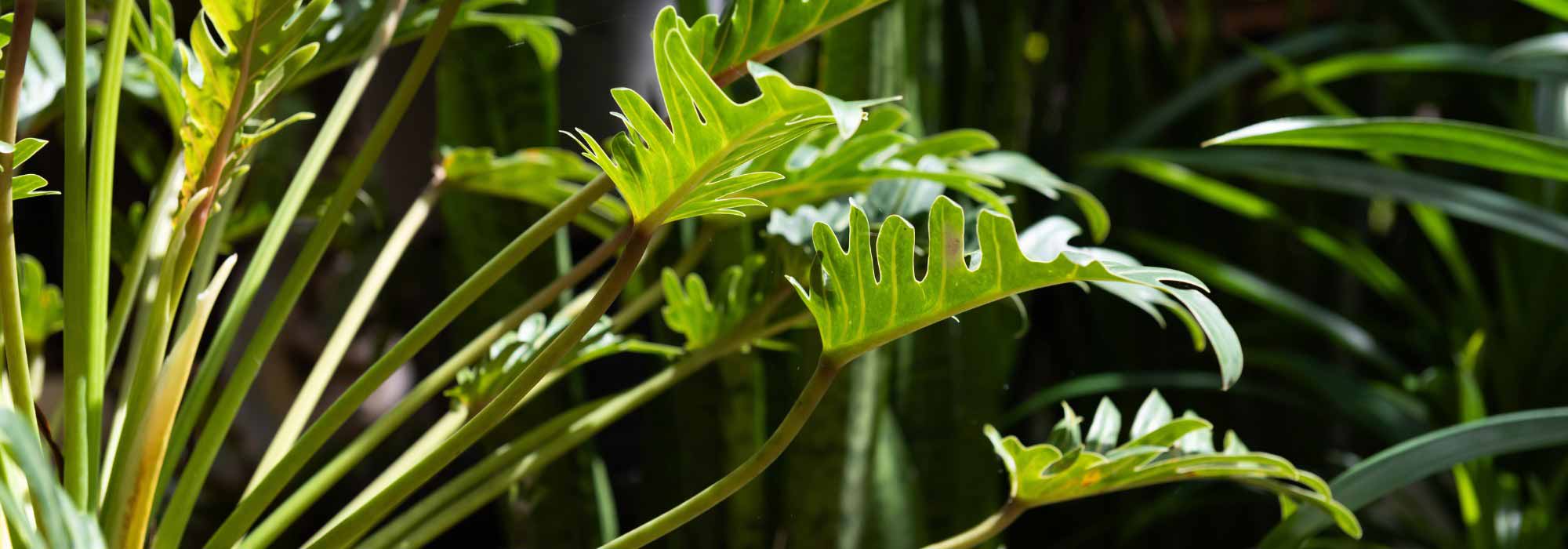
Philodendron: cultivation, care and tips
Contents
Philodendron in a nutshell
- It is a tropical plant native to the humid forests of Central and South America.
- Its lush and varied foliage adds a touch of exoticism and elegance to any interior.
- It enjoys gentle light and moderate watering, making it easy to maintain.
- Its robustness allows it to adapt perfectly to indoor environments, even for beginners.
- It helps to purify the air and create a tropical and healthy atmosphere.
A word from our expert
Whether it adopts a climbing habit or a bushy form, with generous lush leaves, the Philodendron adds a “jungle” touch to any interior. From classic varieties like Philodendron scandens, with its heart-shaped leaves and trailing habit, to more spectacular species like Philodendron gloriosum with its velvety, veined foliage, each Philodendron has its own personality. Collectors and plant enthusiasts also seek out rarer and more precious varieties, such as Philodendron ‘Jose Buono’ with its stunning variegation or Philodendron ‘Paraiso Verde’, known for its light green marbled foliage.
The Philodendron is a remarkably robust plant, capable of easily adapting to indoor life. It enjoys gentle light, without direct sun exposure, and requires moderate watering, allowing the substrate to dry slightly between waterings.
Discover how to cultivate this tropical plant in your home for an exotic decor!
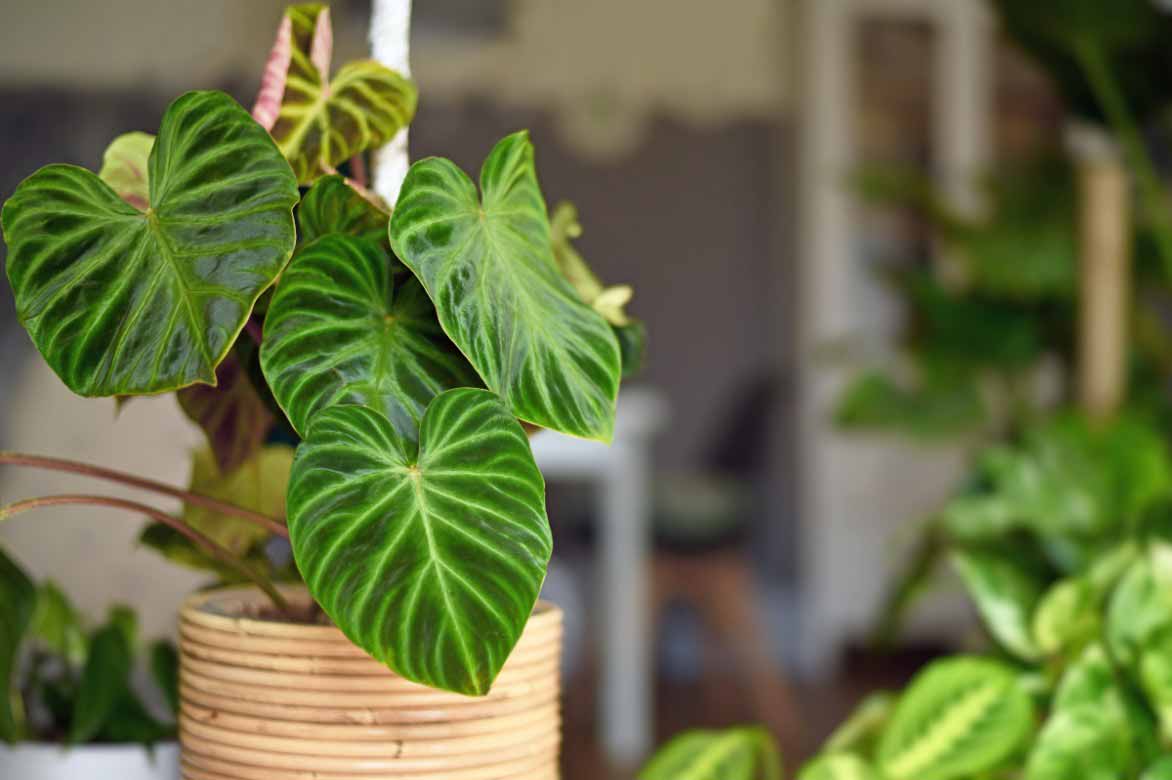
Philodendron verrucosum
Botany
Botanical data
- Latin name Philodendron spp.
- Family Araceae
- Common name Philodendron, Climbing Arum
- Flowering Rare indoors
- Height From 30 cm to over 3 metres
- Exposure Bright
- Soil type Light, rich and well-drained
- Hardiness Frost-sensitive, exclusively indoors in our climates
The Philodendron belongs to the large family of Araceae, known for its tropical plants with lush foliage. The genus Philodendron includes around 500 to 600 officially recognised species. This diversity makes Philodendron one of the largest genera in the Araceae family. Commonly referred to as Philodendron or sometimes Monstera by confusion, Philodendron is distinguished by its wide variety of forms and habits, reflecting its incredible adaptability. Depending on the species, it can adopt a climbing habit, clinging to tree trunks with its aerial roots, or a more bushy and self-supporting habit, forming dense clumps. This flexibility allows it to thrive both on the ground and suspended or leaning against a support.
The plant derives its name from the Greek “philo” meaning love and “dendron” for tree, perfectly illustrating its climbing or epiphytic nature, as a “tree-loving” plant that seems to embrace the trunks of trees in its natural habitat. In the wild, Philodendrons thrive under the humid tropical forests of Central and South America, where they climb along trunks or cover the ground in search of light. This warm and humid environment provides ideal conditions, particularly in shaded areas rich in organic matter.
Its root system is particularly developed and plays a key role in its adaptation. It has underground roots that ensure anchorage and nutrient absorption, but especially aerial roots that allow it to cling to supports and capture ambient moisture. These secondary roots are essential for its growth, especially in the humid tropical environments where it naturally evolves.
Among the most popular species are varieties prized for their decorative foliage, such as Philodendron scandens with its trailing habit or the majestic Philodendron selloum with its large lobed leaves. The species Philodendron erubescens is one of the most popular and widespread among Philodendrons, particularly due to the wide variety of its colourful cultivars such as Philodendron ‘Pink Princess’, ‘Pink Marble’, ‘Black Cardinal’, ‘Royal Queen’, ‘Red Congo’, and ‘Imperial Red’, remarkable for their foliage in shades of pink, dark, or deep red. The varieties ‘Malay Gold’ and ‘Moonlight’ offer golden and lemony hues. The Philodendron hederaceum, particularly in its scandens form (often called Heartleaf Philodendron), is also very common and appreciated for its trailing habit and easy care. This one is particularly popular in our homes and offices due to its great adaptability.
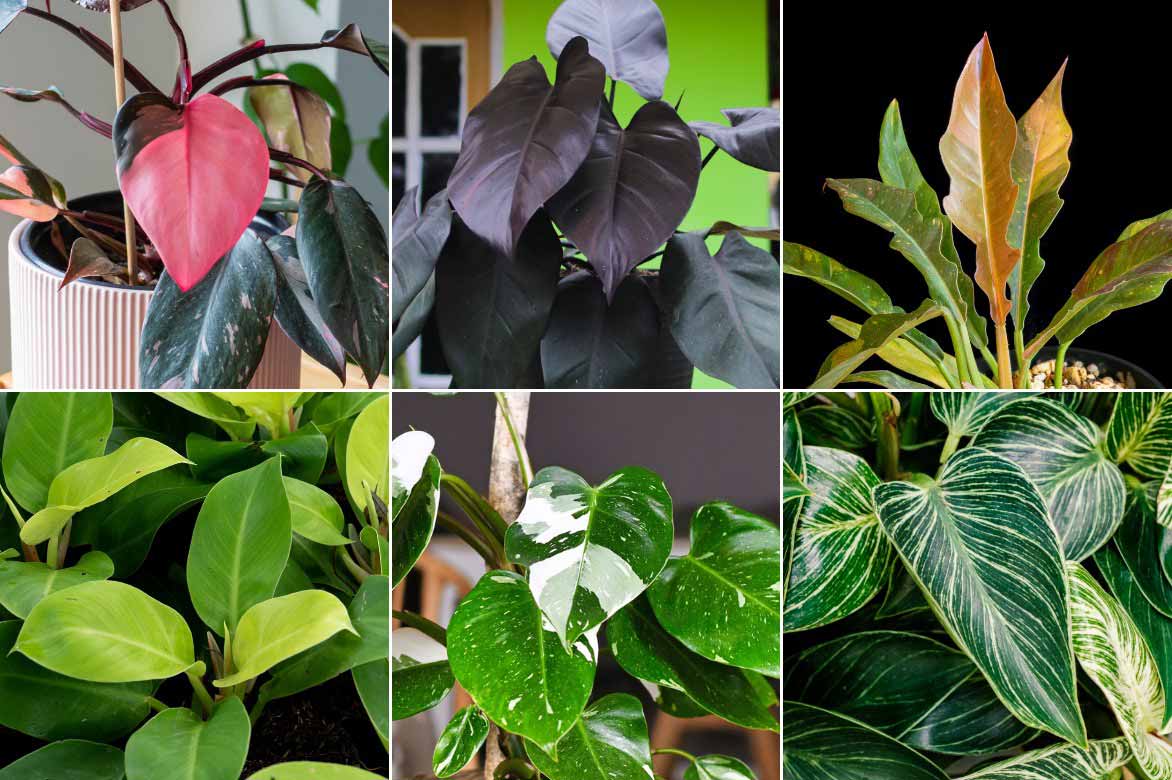
The different varieties of Philodendron offer a great diversity in foliage colours: Philodendron ‘Pink Princess’, ‘Royal Queen’, ‘Ring of Fire’, ‘Moonlight’, ‘White Princess’, and ‘White Measure’
The foliage of the Philodendron is its main attraction. It is extremely varied, offering very distinct shapes and textures. Its leaves are generally broad, glossy, and leathery, but they vary greatly from one species to another. Its leaves can be entire, heart-shaped (as in Philodendron hederaceum), deeply lobed (in Philodendron bipinnatifidum or selloum), and almost serrated (in Philodendron elegans), but they mostly do not exhibit natural perforations like those found in Monstera, with which it is frequently confused.
The colour palette is equally rich, ranging from deep green to golden green, with shades of red, pink, and even black. Some hybrid and rare species, such as Philodendron Billietiae x Atabapoense or Philodendron Jungle Selloum x Goeldii, testify to the botanical richness of the genus, combining original shapes and striking colours. The spectacular Philodendron ‘Ring of Fire’ captivates with its serrated leaves variegated in green, orange, and cream, while Philodendron ‘White Princess’ and Philodendron ‘White Measure’ bring subtle elegance with their white veins.
The inflorescence of the Philodendron, although discreet compared to its foliage, is typical of plants in the Araceae family. It consists of a fleshy spadix, enveloped by a spathe, a type of bract that can be white, cream, or greenish. This flowering remains quite rare in indoor cultivation, as it requires very specific conditions of heat and humidity. In its natural environment, this inflorescence plays an important role in reproduction, attracting certain pollinating insects.
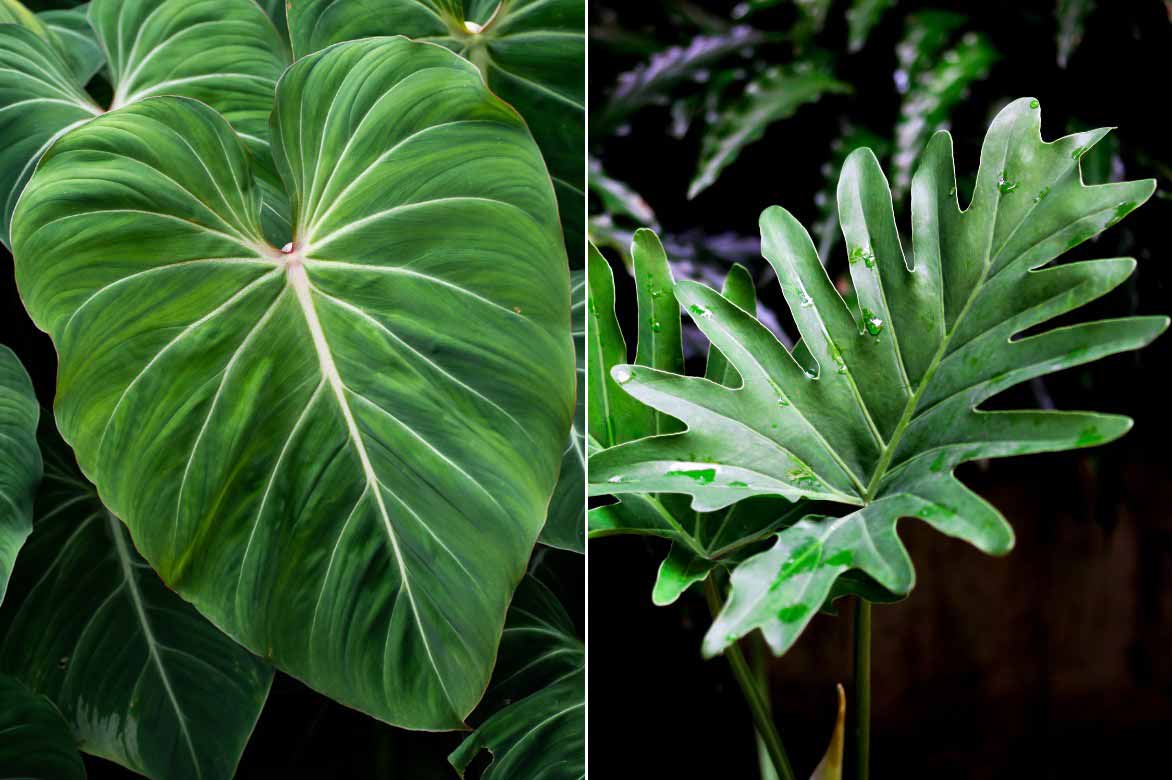
The leaves of the Philodendron can be entire or lobed. On the left, Philodendron gloriosum, and on the right, Philodendron selloum
Main species and varieties
Philodendron Red Congo
Philodendron 69686
Philodendron applanatum
Philodendron billietiae x atabapoense
Philodendron Birkin Ribbon
Philodendron Black Cardinal
Philodendron burle-marxii
Philodendron Caramel Marble
Philodendron Caramel Pluto
Philodendron Cherry Red
Philodendron sp Colombia
Philodendron elegans
Philodendron Fat Boy
Philodendron Florida Ghost
Philodendron grazielae
Philodendron gloriosum
Philodendron Holtonianum Trilobe
Philodendron Imperial Green
Philodendron Imperial Red
Philodendron Incensi
Philodendron Ivory Vein
Philodendron joepii
Philodendron Jose Bueno
Philodendron Jose Buono
Philodendron Jungle selloum x goeldii
Philodendron longilobatum
Philodendron Malay Gold
Philodendron mexicanum
Philodendron minima
Philodendron Moonlight
Philodendron Painted Lady
Philodendron Paraiso Verde
Philodendron Pink Marble
Philodendron Pink Princess
Philodendron pittieri red
Philodendron Prince of Orange
Philodendron radiatum
Philodendron Red Heart
Philodendron Ring of Fire
Philodendron Royal Queen
Philodendron rugosum Abberant
Philodendron Sun Red
Philodendron Sunlight
Philodendron tortum
Philodendron Violin Gold
Philodendron White Measure
Philodendron White Princess
Philodendron Xanadu
Planting Philodendron
Where to place the philodendron in a house?
The Philodendron thrives when placed in an environment that mimics the tropical conditions of its natural habitat. It enjoys bright spots, but without direct sunlight, which could scorch its foliage. The ideal location is near a large window facing north or south-east or south-west. A temperate room, sheltered from cold or hot drafts, with sufficient ambient humidity, provides an ideal setting. A filtered light helps to preserve the beauty of the foliage. Be careful, insufficient light will slow its growth. Once established, the Philodendron benefits from a gentle atmosphere to develop its lush foliage.
When to plant it?
Planting can be done at any time of the year indoors.
How to plant a Philodendron step by step:
The substrate should be light, rich, and well-drained to prevent water accumulation at the roots. A potting mix for green plants mixed with a bit of perlite promotes good rooting.
- Choose a pot slightly larger than the root ball, with drainage holes at the bottom. The roots of the Philodendron are sensitive to excess water.
- Mix potting soil for green plants with perlite, coconut fibre, sphagnum, or pine bark to facilitate good drainage.
- Place clay balls or gravel at the bottom of the pot to prevent water from stagnating.
- Gently remove the Philodendron from its original pot and lightly loosen the roots if they are too compacted.
- Position the root ball in the centre of the pot without burying the collar (the base of the stem) and fill the space around it with the prepared soil mix.
- Gently press the soil around the root ball to stabilise the plant, without compacting it too much.
- Moisten the substrate immediately after planting, but do not saturate the soil. Ensure that water drains well through the drainage holes.
- Place your Philodendron in a bright spot, without direct sunlight, with a stable temperature and good ambient humidity.
Discover Leila’s tips for Growing philodendrons indoors
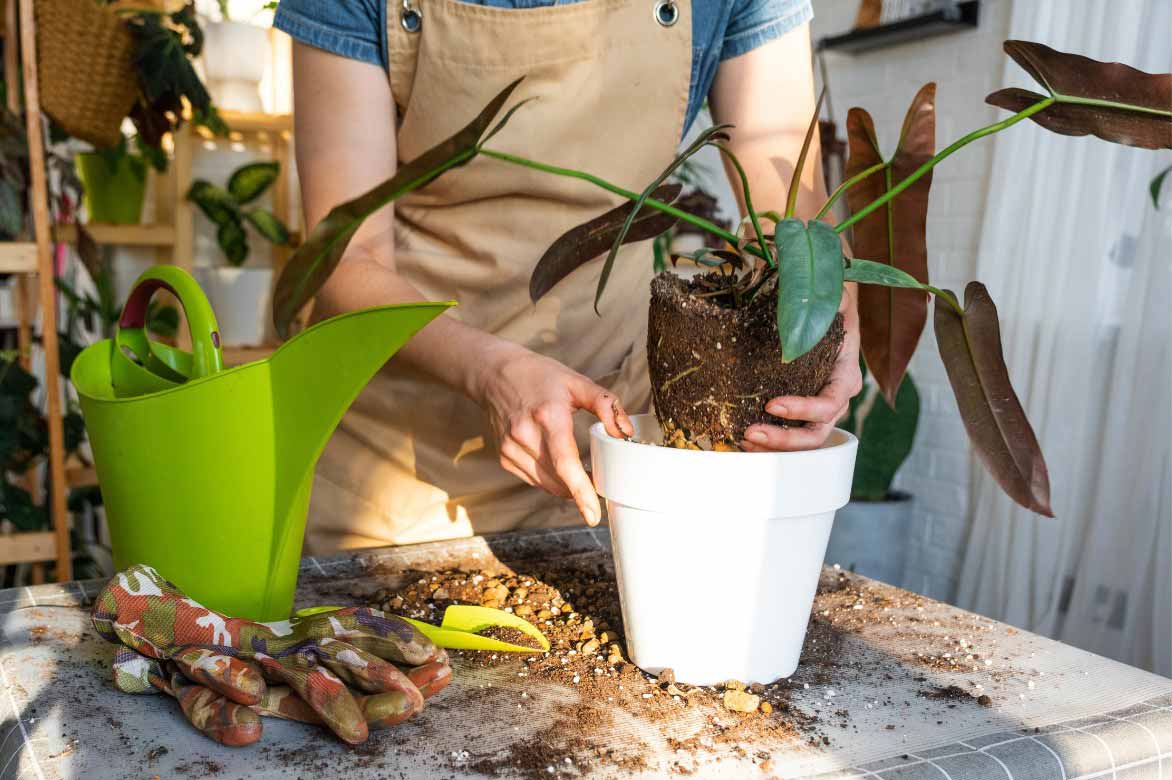
Planting a Philodendron ‘Santa Leopoldina’
How to care for a philodendron?
To properly care for your Philodendron and promote its growth, a few simple actions are sufficient. Water moderately, allowing the surface of the substrate to dry between waterings. In summer, watering once a week is often enough, while in winter, space out the water supply.
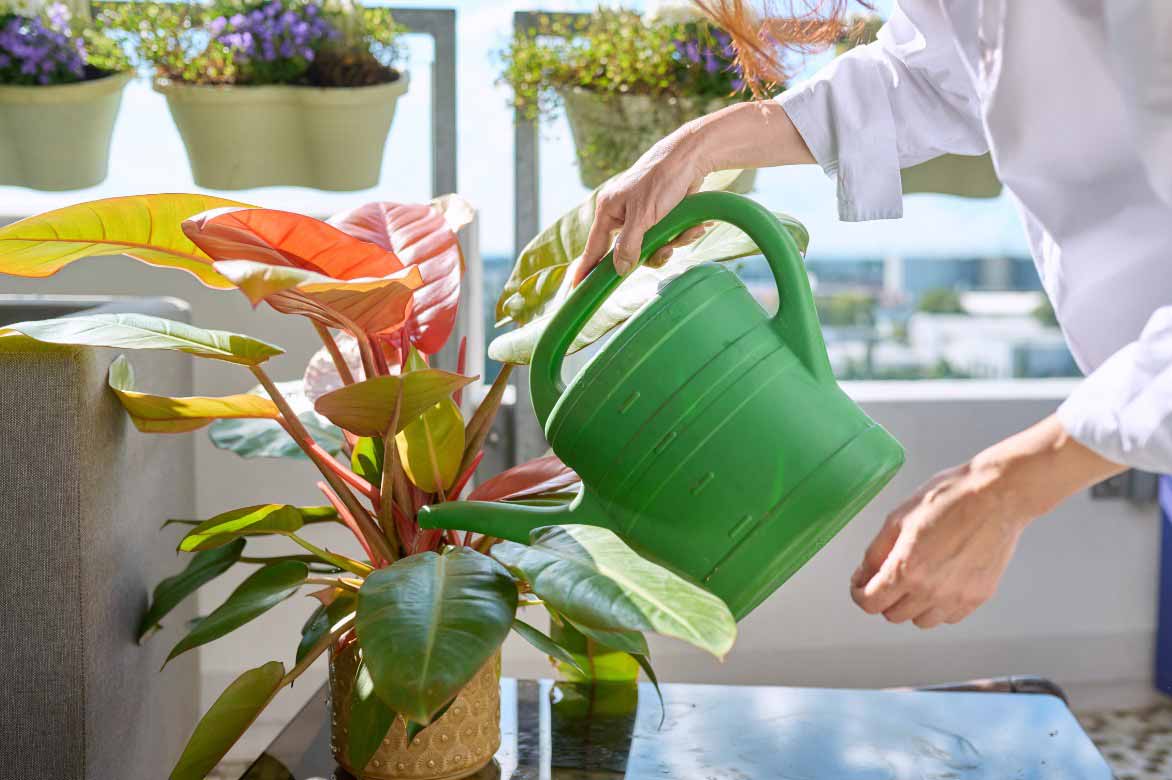
Remember to water your Philodendron regularly
The Philodendron enjoys a humid atmosphere. You can regularly mist its leaves with non-calcareous water (rainwater is perfect), especially during the heating season, or place the pot on a bed of moist clay balls to increase ambient humidity. However, ensure that water does not stagnate in the saucer to avoid root rot.
During the growth period (from spring to autumn), apply a liquid fertiliser for green plants once a month. In winter, stop fertilising.
Prune overly long or unruly stems to encourage a more compact habit. Regularly remove yellowed or damaged leaves to stimulate new shoots and keep the plant healthy. Gently wipe the leaves with a damp cloth to remove dust and allow the plant to breathe better and capture light.
Repot your Philodendron every two to three years, preferably in spring, when the roots start to become cramped.
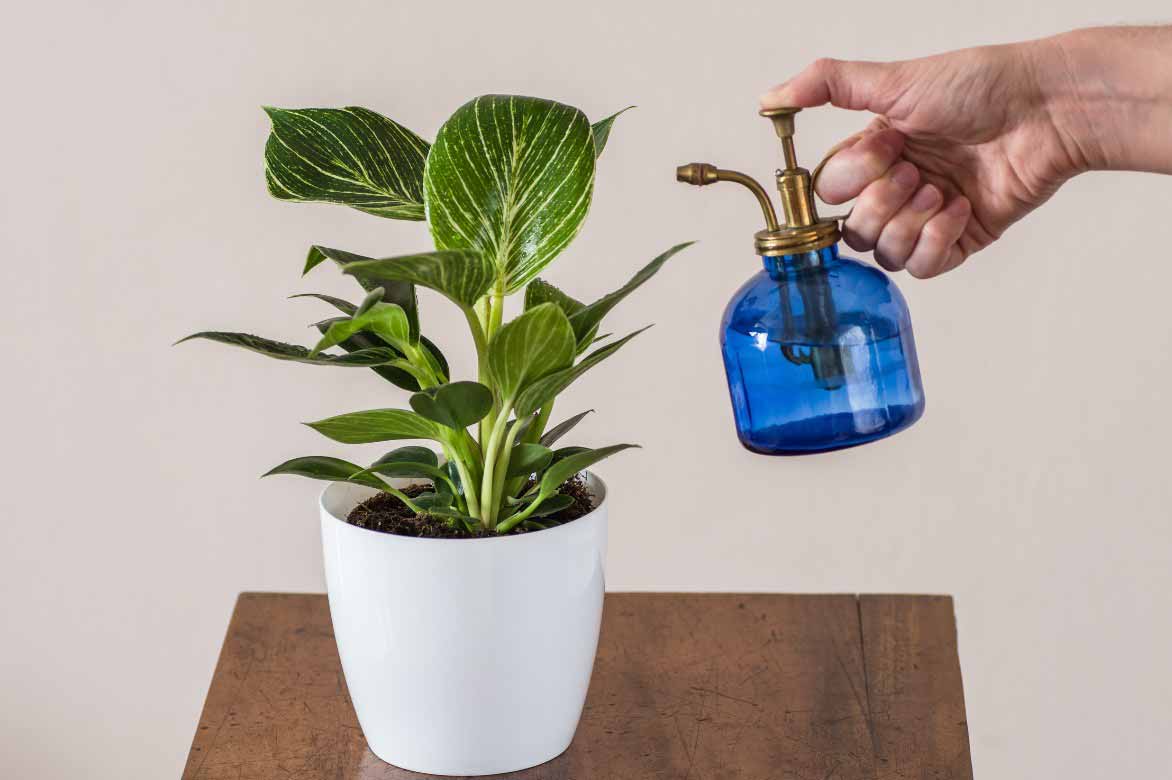
The Philodendron will appreciate it if you mist its foliage from time to time
Diseases and potential pests
Philodendron, although robust, can sometimes be vulnerable to certain issues. An excess of moisture or poor drainage encourages the development of fungal diseases such as root rot, which manifests as yellowing of the leaves and softened stems.
An environment that is too dry or confined air attracts pests such as mealybugs, which settle under the leaves and leave cottony deposits, or spider mites that cause leaf desiccation with fine webs. Aphids can also target young shoots by sucking the sap, which slows down growth. To eliminate the unwanted pests, spray diluted black soap at 15 to 30 g per litre of water.
Finally, excessive light can cause leaf burn, while too much fertiliser can yellow the edges of the leaves. Careful maintenance and suitable growing conditions generally help to prevent these issues.
→ Read our articles to learn more about suitable treatments: aphids, mealybugs, spider mites.
How to take a cutting of Philodendron?
Making a Philodendron cutting in water or potting soil is a simple and effective method to propagate this tropical plant. Here are the steps to successfully carry out your propagation:
- Select a vigorous stem with at least one node (the point from which leaves and roots emerge) and a few leaves. Choose a stem without signs of disease or weakness.
- Using a clean and sharp pruning shear, cut just below the node. The cutting should measure about 10 to 15 cm. Remove the lower leaves.
- Choose the propagation method:
- In water: Submerge the node in a glass of clean water, ensuring that the leaves do not touch the water. Change the water every 3 to 4 days to prevent the proliferation of bacteria.
- In potting soil: Plant the cutting in a light and well-draining mix (potting soil for houseplants, perlite, and coconut fibre). Keep the substrate slightly moist and place the cutting under a cloche or plastic bag to maintain humidity.
4. Position the cutting in a bright location, avoiding direct sunlight. An ambient temperature of 20 to 25 °C will encourage root development.
5. After 2 to 4 weeks, small roots will begin to develop. When the roots reach a few centimetres in length, you can repot the cutting if it was in water or continue with regular care if it was in soil.
6. Transplant the rooted cutting very gently into a pot with a rich and well-draining substrate.
7. Water lightly and place the plant in a bright location.
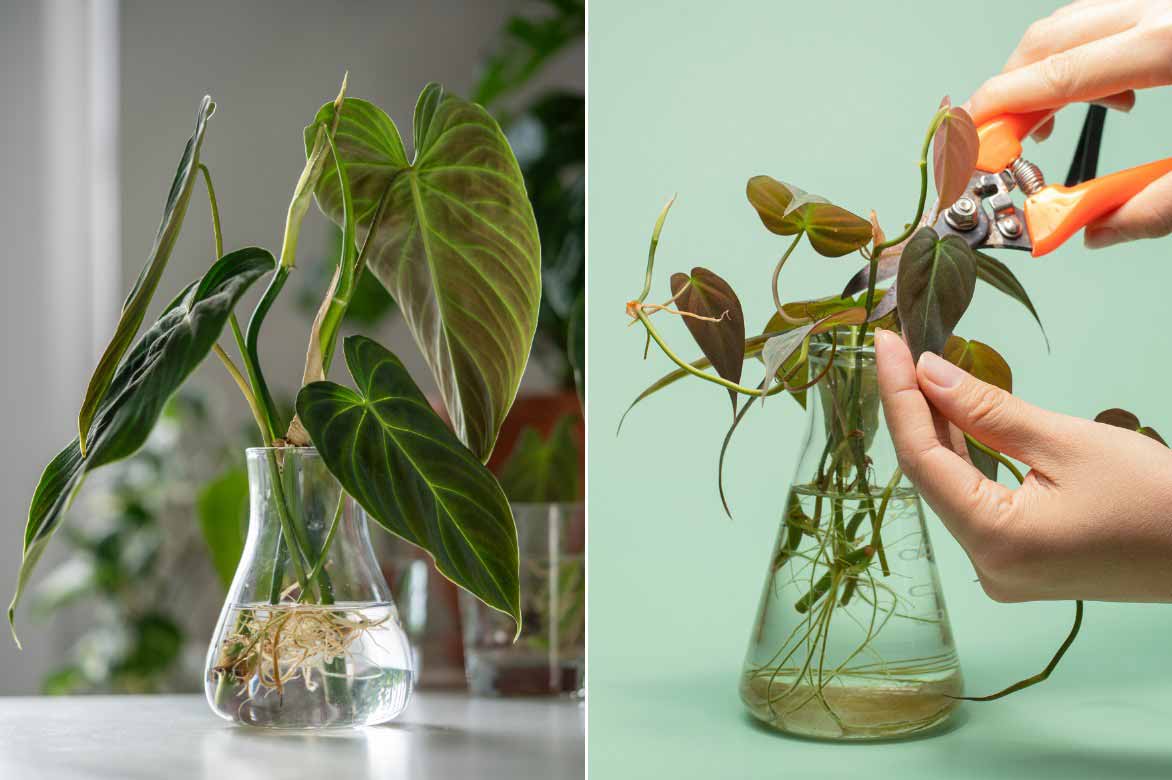 You can easily propagate Philodendron by cutting it in water or directly in soil.</caption]
You can easily propagate Philodendron by cutting it in water or directly in soil.</caption]
How to showcase a Philodendron effectively?
It integrates beautifully into a bohemian decor with wicker baskets and natural textiles, but also in a more modern style with minimalist pots and metal or wood shelves. Its beautiful greenery brings softness to a clean living room or freshness to a cosy office. Quite easy to care for, it enjoys warm and slightly humid environments, making it a perfect guest in a bright bathroom. Placed high on a shelf or suspended in a macramé, it allows its long stems to elegantly cascade, adding movement and softness to the room.
The Philodendron loves natural materials like raw wood, ceramic, or rattan, which highlight its glossy foliage. Unfussy, it finds its place in both contemporary spaces and vintage decor.
What is the difference between a Philodendron and a Monstera?
Philodendron and Monstera are two distinct genera belonging to the same family, Araceae, but they exhibit notable differences in terms of morphology, growth, and origin. Both genera are native to the tropical forests of Central and South America, but Monstera is more specifically adapted to humid understoreys where it climbs on tree trunks, while Philodendron is more diverse and occupies different levels of the tropical forest. Monstera is famous for its large, cut and perforated leaves, while Philodendron offers a greater diversity of leaf shapes, without natural perforations. Although they share tropical origins and similar needs, they remain two distinct genera with their own botanical characteristics.
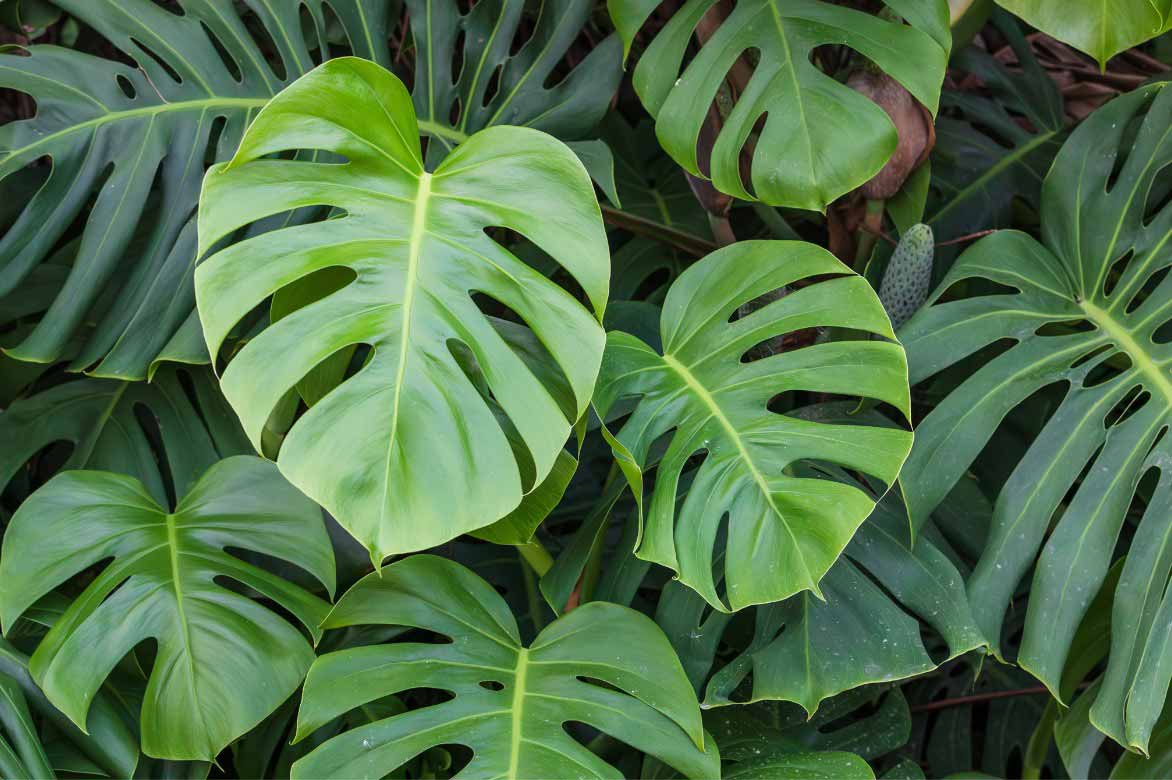
The foliage of Monstera deliciosa
Useful resources
- Discover our range of indoor green plants and flowering plants to bring exoticism and elegance to your home.
- Our selection of books on indoor plants.
- Subscribe!
- Contents
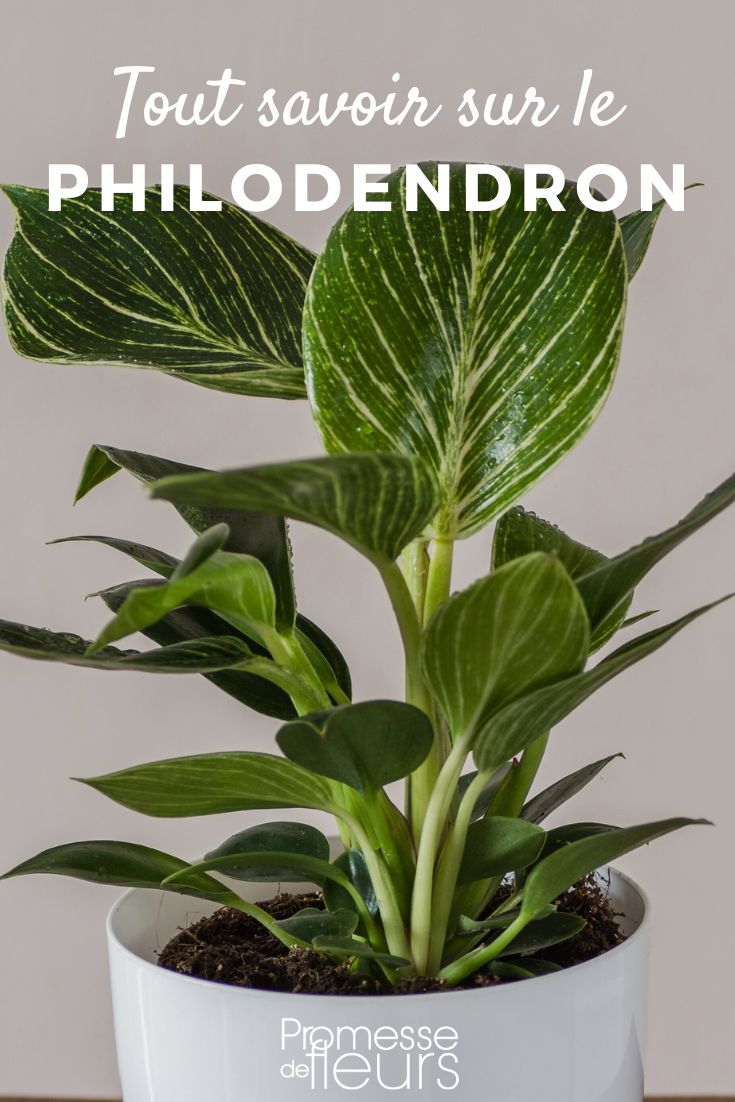































Comments